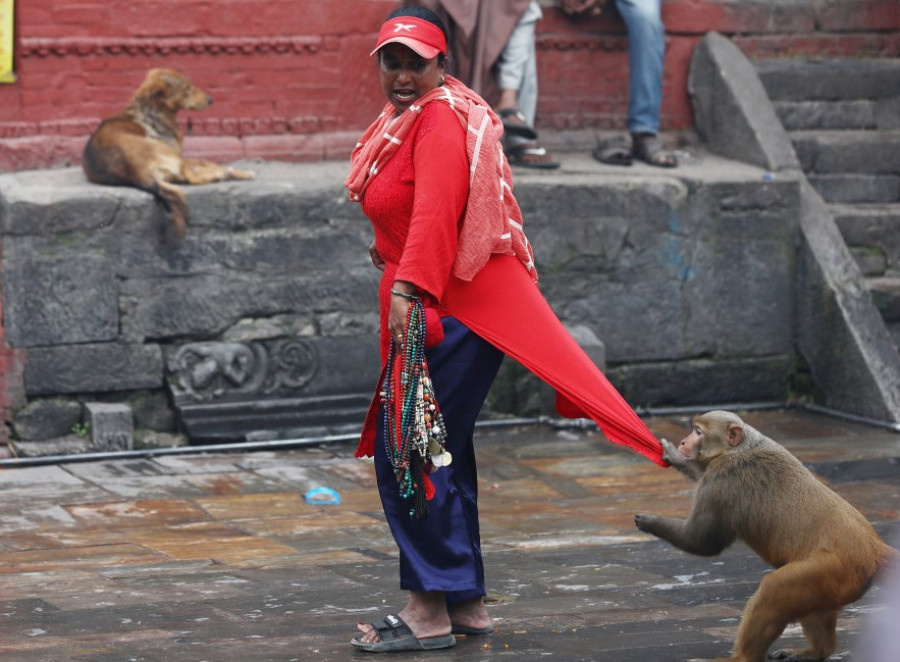Columns
Alarming rise in monkey bites
The issue is one of Nepal’s leading but overlooked public health concerns.
Dr Sher Bahadur Pun
A nine-year-old boy from Mahottari-9 recently visited the Sukraraj Tropical and Infectious Disease Hospital (STIDH) in Teku, seeking treatment and vaccination against rabies virus due to the unavailability and shortage of vaccine in the area. He was bitten by a monkey. Another victim’s father told me that nearly 4,000 people had been victims of the same monkey over the past two to three months. Interestingly, this monkey used to drink alcohol with residents at the shops and bite children when it became aggressive or wild.
Every day, monkey bite victims come to STIDH to receive counselling and to get vaccinated. In fact, as per the hospital’s data, monkeys are the second most common cause of animal bites in Nepal, after dogs. So far, no rabies cases from monkey bites have been reported/documented in Nepal. However, the incident has continued to increase at an alarming rate in Nepal, and its potential health consequences are unknown.
Monkeys are commonly seen in and around Hindu and Buddhist temples in Nepal and are considered “holy”. Interactions between humans and monkeys are common in temple areas, where visitors offer food items or monkeys grab their belongings. A few months ago, a monkey-bite victim informed me that dozens of people had been injured in similar attacks in Balaju temple in Kathmandu. Many such unprovoked attacks against visitors or residents are reported in Kathmandu annually. However, despite the potential threat of infectious diseases, such incidents don’t draw the attention of the authorities.
Hospital data spanning 14 years shows that monkey bite cases usually peak during July-August in Nepal, suggesting a monkey bite epidemic may be observed in the coming weeks. During this period, women become victims of monkey bites. July and August are considered holy months, and many women visit temples to perform worship, especially Lord Shiva’s Pashupatinath temple. According to the Pashupati Area Development Trust, around 600 monkeys (maybe even more) reside in the Pashupat areas. Likewise, Swayambhunath, a Buddhist temple, is also home to hundreds of monkeys, from where some monkey bite victims regularly come to STIDH to get vaccinated, but not all. It is, therefore, unclear whether monkey bite victims are suffering from any other potential known/unknown infectious diseases or having treatment elsewhere. Conflicts between monkeys and residents in rural areas are also reported frequently in local media.
A few years ago, a study was conducted at Swayambhunath temple to evaluate a potential threat of zoonotic diseases, which can be transmitted from monkeys to humans. The researchers used laboratory techniques to identify viruses in biological samples taken from monkeys in the temple. The study found that many monkeys were infected with various viruses. Although some of the viruses pose a threat to human health, information or its impact on the community remains unknown. This study was published in the Emerging Infectious Disease journal in 2006.
The National Guideline for Rabies Prophylaxis was revised and published in 2019 to provide information on animal bites and their management in Nepal. Unfortunately, this guideline fails to address the risk and management of monkey bites. Although no rabies cases have been reported due to monkey bites in Nepal, the possibility of contracting rabies from a monkey bite cannot be ruled out.
A study published in the Journal of Travel Medicine in 2016 demonstrated the rabies virus in a dead monkey in Shimla municipality, India, suggesting that monkey bite is not risk-free. The researchers of this study assumed that the rabies virus found in a dead monkey might be due to interaction with rabies-carrying stray dogs. In Nepal, interactions or conflicts between stray dogs and monkeys are common. A letter to the editor section published in the same journal reported that in Andhra Pradesh, India, a young adult male developed rabies symptoms and died three weeks after being bitten by a monkey on his left upper arm. Monkey bite issue, thus, must be addressed or described in the National guideline for Rabies Prophylaxis. STIDH regularly administers anti-rabies vaccines to those who come to us after being bitten by a monkey.
Monkey bite is one of Nepal’s leading but overlooked public health concerns. There is a lack of documentation on infectious diseases that may arise in humans after being bitten by a monkey. Although some studies have found viruses in monkeys residing in temples, their potential impact on the community's health remains obscure. The reason for this is quite simple: The concerned authorities do not pay adequate attention and study regarding animal bites, particularly monkey bite injuries in Nepal. Monkey bites are the second leading cause of animal bites in Nepal. The short- and long-term health impacts must be explored and incorporated into the national guidelines accordingly.




 24.12°C Kathmandu
24.12°C Kathmandu
.jpg&w=200&height=120)














